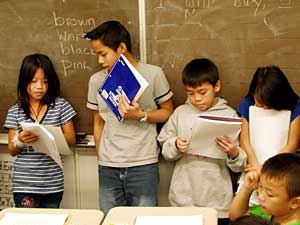| The Hmong in Minnesota |
|
Audio
Photos
Your Voice
|
Schools slowly filling with Hmong refugees
November 15, 2004
 |
| Students in a Transitional Language Center classroom at Como Park Elementary school prepare to read aloud. (MPR Photo/Tim Pugmire) |
St. Paul, Minn. — St. Paul School District officials expected as many as 1,000 Hmong refugee students this year. They just didn't know when they'd show up, or which grades levels they'd need to be placed in.
 | |||
As students arrive, they're sent to special bilingual classrooms in one of three elementary schools -- Como Park, Hayden Heights or Phalen Lake. Older students are funneled to the former Wilson Junior High. Valeria Silva, the district's director of English Language Learner programs, says the enrollment options were intentionally limited to just a few schools.
"We wanted to make sure families would stay together," said Silva. "We have in St. Paul 51 elementary schools. And in each of the schools are vacancies at different levels. We knew the students would be coming in September, which means most of the classrooms in schools are full by then. And they may have two openings in first grade, one opening in fifth grade. So, we wanted to make sure that families were not split between three or four schools."
Fourth, fifth and sixth grade students share a crowded Transitional Language Center classroom at Como Park Elementary. Students are divided into small groups based on their reading ability. They're eager to answer questions. Teacher Xay Thaw sits close to her students at a small, low table. She says the children are fluent in Hmong, but need a lot of work on English.
 | |||
"My most important role here is to help them with the Hmong and with the English with a translation," Thaw said. "If I'm able to explain it in Hmong to them, they can grasp it really easily. But it's the vocabulary in the English language that's really hard for them."
There's a wide range of educational experience among the students. Many children received formal instruction while living in Thailand, but others did not.
Teacher Mark Thompson says some students arrived without a basic understanding of numbers or letters. In addition to academics, Thompson says he's teaching students about the rituals and routines of the school day.
"We practiced the bathroom, going to the bathroom, lining up and going to the lunchroom and how to enter in their lunchroom number," Thompson said. "What's been exciting in the four or five weeks is that the students who have been here now are educating the students who have recently come."
Thompson says he's seen a lot of academic progress among his students in just two months. Most students will spend about a year in the program before moving into mainstream classrooms. Sixth grader Chue Chang has been at Como since the beginning of the school year, and is feeling comfortable with his new surroundings.
 | |||
"I like Como school," Chang said.
The slow arrival of students has put a financial pinch on St. Paul schools. Most of the students showed up after Oct. 1, which is the date official enrollment counts are taken to calculate state funding levels. That puts the district short on resources for the school year. Valeria Silva says it takes money to get immigrant students on track.
"The majority of them have come with very little or no education," Silva said. "Not only are they learning language, they're learning culture. And they're going to be assessed in the following year using the same measurements that we use at the state level for English speakers. So it requires intensive language methodology to be used, which is expensive because it requires more staff."
There's still room for about 30 students at Como, and slightly more at each of the other two elementary schools. Still, district officials know another wave of refugee students could quickly fill those spots. They plan to expand the transitional language program in January to Parkway and Groveland Park schools.
|
News Headlines
|
Related Subjects
|

